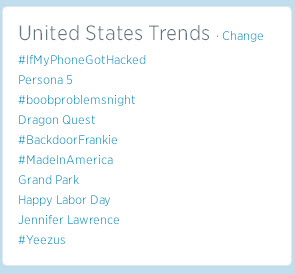|
apache — openoffice |
The OLE preview generation in Apache OpenOffice before 4.1.1 and OpenOffice.org (OOo) might allow remote attackers to embed arbitrary data into documents via crafted OLE objects. |
2014-08-26 |
4.3 |
CVE-2014-3575
XF
SECTRACK
BUGTRAQ |
|
apache — axis |
The getCN function in Apache Axis 1.4 and earlier does not properly verify that the server hostname matches a domain name in the subject’s Common Name (CN) or subjectAltName field of the X.509 certificate, which allows man-in-the-middle attackers to spoof SSL servers via a certificate with a subject that specifies a common name in a field that is not the CN field. NOTE: this issue exists because of an incomplete fix for CVE-2012-5784. |
2014-08-26 |
5.8 |
CVE-2014-3596
XF
SECTRACK
BID
MLIST |
|
check_mk_project — check_mk |
Multiple cross-site scripting (XSS) vulnerabilities in the multisite component in Check_MK before 1.2.4p4 and 1.2.5 before 1.2.5i4 allow remote authenticated users to inject arbitrary web script or HTML via unspecified vectors to the (1) render_status_icons function in htmllib.py or (2) ajax_action function in actions.py. |
2014-08-22 |
4.3 |
CVE-2014-5338
XF
BID
BUGTRAQ
MISC |
|
christos_zoulas — file |
Integer overflow in the cdf_read_property_info function in cdf.c in file through 5.19, as used in the Fileinfo component in PHP before 5.4.32 and 5.5.x before 5.5.16, allows remote attackers to cause a denial of service (application crash) via a crafted CDF file. NOTE: this vulnerability exists because of an incomplete fix for CVE-2012-1571. |
2014-08-22 |
4.3 |
CVE-2014-3587
CONFIRM
DEBIAN
CONFIRM |
|
cisco — asr_9000_rsp440_router |
Cisco IOS XR 4.3(.2) and earlier on ASR 9000 devices does not properly perform NetFlow sampling of packets with multicast destination MAC addresses, which allows remote attackers to cause a denial of service (chip and card hangs) via a crafted packet, aka Bug ID CSCup77750. |
2014-08-26 |
4.6 |
CVE-2014-3335 |
|
cisco — transport_gateway_installation_software |
Multiple cross-site scripting (XSS) vulnerabilities in the web framework in Cisco Transport Gateway for Smart Call Home (aka TG-SCH or Transport Gateway Installation Software) 4.0 allow remote attackers to inject arbitrary web script or HTML via unspecified parameters, aka Bug IDs CSCuq31129, CSCuq31134, CSCuq31137, and CSCuq31563. |
2014-08-27 |
4.3 |
CVE-2014-3344 |
|
cisco — transport_gateway_installation_software |
The web framework in Cisco Transport Gateway for Smart Call Home (aka TG-SCH or Transport Gateway Installation Software) 4.0 does not properly check authorization for administrative web pages, which allows remote attackers to modify the product via a crafted URL, aka Bug ID CSCuq31503. |
2014-08-28 |
5.0 |
CVE-2014-3345 |
|
cisco — transport_gateway_installation_software |
The web framework in Cisco Transport Gateway for Smart Call Home (aka TG-SCH or Transport Gateway Installation Software) does not validate an unspecified parameter, which allows remote authenticated users to cause a denial of service (service crash) via a crafted string, aka Bug ID CSCuq31819. |
2014-08-29 |
6.3 |
CVE-2014-3346 |
|
cisco — 1801_integrated_service_router |
Cisco IOS 15.1(4)M2 on Cisco 1800 ISR devices, when the ISDN Basic Rate Interface is enabled, allows remote attackers to cause a denial of service (device hang) by leveraging knowledge of the ISDN phone number to trigger an interrupt timer collision during entropy collection, leading to an invalid state of the hardware encryption module, aka Bug ID CSCul77897. |
2014-08-28 |
5.4 |
CVE-2014-3347 |
|
cisco — cloud_portal |
Cisco Intelligent Automation for Cloud (aka Cisco Cloud Portal) does not validate file types during the handling of file submission, which allows remote authenticated users to upload arbitrary files via a crafted request, aka Bug ID CSCuh87410. |
2014-08-29 |
4.0 |
CVE-2014-3349 |
|
cisco — cloud_portal |
Cisco Intelligent Automation for Cloud (aka Cisco Cloud Portal) does not properly implement URL redirection, which allows remote authenticated users to obtain sensitive information via a crafted URL, aka Bug ID CSCuh84870. |
2014-08-29 |
4.0 |
CVE-2014-3350 |
|
cisco — cloud_portal |
Cisco Intelligent Automation for Cloud (aka Cisco Cloud Portal) does not properly consider whether a session is a problematic NULL session, which allows remote attackers to obtain sensitive information via crafted packets, aka Bug IDs CSCuh87398 and CSCuh87380. |
2014-08-29 |
5.0 |
CVE-2014-3351 |
|
debian — python-imaging |
PIL/IcnsImagePlugin.py in Python Imaging Library (PIL) and Pillow before 2.3.2 and 2.5.x before 2.5.2 allows remote attackers to cause a denial of service via a crafted block size. |
2014-08-25 |
5.0 |
CVE-2014-3589
DEBIAN |
|
djangoproject — django |
The core.urlresolvers.reverse function in Django before 1.4.14, 1.5.x before 1.5.9, 1.6.x before 1.6.6, and 1.7 before release candidate 3 does not properly validate URLs, which allows remote attackers to conduct phishing attacks via a // (slash slash) in a URL, which triggers a scheme-relative URL to be generated. |
2014-08-26 |
5.8 |
CVE-2014-0480
DEBIAN |
|
djangoproject — django |
The default configuration for the file upload handling system in Django before 1.4.14, 1.5.x before 1.5.9, 1.6.x before 1.6.6, and 1.7 before release candidate 3 uses a sequential file name generation process when a file with a conflicting name is uploaded, which allows remote attackers to cause a denial of service (CPU consumption) by unloading a multiple files with the same name. |
2014-08-26 |
4.3 |
CVE-2014-0481
DEBIAN |
|
djangoproject — django |
The contrib.auth.middleware.RemoteUserMiddleware middleware in Django before 1.4.14, 1.5.x before 1.5.9, 1.6.x before 1.6.6, and 1.7 before release candidate 3, when using the contrib.auth.backends.RemoteUserBackend backend, allows remote authenticated users to hijack web sessions via vectors related to the REMOTE_USER header. |
2014-08-26 |
6.0 |
CVE-2014-0482
DEBIAN |
|
esri — arcgis_for_server |
Multiple cross-site scripting (XSS) vulnerabilities in ESRI ArcGIS for Server 10.1.1 allow remote attackers to inject arbitrary web script or HTML via unspecified parameters. |
2014-08-22 |
4.3 |
CVE-2014-5121
BUGTRAQ
MISC |
|
esri — arcgis_for_server |
Open redirect vulnerability in ESRI ArcGIS for Server 10.1.1 allows remote attackers to redirect users to arbitrary web sites and conduct phishing attacks via an unspecified parameter, related to login. |
2014-08-22 |
5.8 |
CVE-2014-5122
BID
BUGTRAQ
MISC |
|
google — chrome |
extensions/common/url_pattern.cc in Google Chrome before 37.0.2062.94 does not prevent use of a ” character in a host name, which allows remote attackers to spoof the extension permission dialog by relying on truncation after this character. |
2014-08-26 |
6.4 |
CVE-2014-3170
CONFIRM |
|
google — chrome |
The Debugger extension API in browser/extensions/api/debugger/debugger_api.cc in Google Chrome before 37.0.2062.94 does not validate a tab’s URL before an attach operation, which allows remote attackers to bypass intended access limitations via an extension that uses a restricted URL, as demonstrated by a chrome:// URL. |
2014-08-26 |
6.4 |
CVE-2014-3172
CONFIRM |
|
google — chrome |
The WebGL implementation in Google Chrome before 37.0.2062.94 does not ensure that clear calls interact properly with the state of a draw buffer, which allows remote attackers to cause a denial of service (read of uninitialized memory) via a crafted CANVAS element, related to gpu/command_buffer/service/framebuffer_manager.cc and gpu/command_buffer/service/gles2_cmd_decoder.cc. |
2014-08-26 |
5.0 |
CVE-2014-3173
CONFIRM |
|
google — chrome |
modules/webaudio/BiquadDSPKernel.cpp in the Web Audio API implementation in Blink, as used in Google Chrome before 37.0.2062.94, does not properly consider concurrent threads during attempts to update biquad filter coefficients, which allows remote attackers to cause a denial of service (read of uninitialized memory) via crafted API calls. |
2014-08-26 |
5.0 |
CVE-2014-3174
CONFIRM |
|
hp — service_manager |
Cross-site scripting (XSS) vulnerability in the Mobility Web Client and Service Request Catalog (SRC) components in HP Service Manager (SM) 7.21 and 9.x before 9.34 allows remote attackers to inject arbitrary web script or HTML via unspecified vectors. |
2014-08-23 |
4.3 |
CVE-2013-6222 |
|
hp — service_manager |
Cross-site request forgery (CSRF) vulnerability in the server in HP Service Manager (SM) 7.21 and 9.x before 9.34 allows remote attackers to hijack the authentication of unspecified victims via unknown vectors. |
2014-08-23 |
6.8 |
CVE-2014-2633 |
|
ibm — power_710 |
Unspecified vulnerability on IBM Power 7 Systems 740 before 740.70 01Ax740_121, 760 before 760.40 Ax760_078, and 770 before 770.30 01Ax770_062 allows local users to gain Service Processor privileges via unknown vectors. |
2014-08-22 |
4.6 |
CVE-2013-6306
XF |
|
ibm — mobile_foundation |
IBM Worklight Foundation 5.x and 6.x before 6.2.0.0, as used in Worklight and Mobile Foundation, allows remote authenticated users to bypass the application-authenticity feature via unspecified vectors. |
2014-08-29 |
4.9 |
CVE-2014-0888
XF |
|
ibm — maximo_asset_management |
Cross-site request forgery (CSRF) vulnerability in IBM Maximo Asset Management 7.1 through 7.1.1.12 and 7.5 through 7.5.0.6 and Maximo Asset Management 7.5.0 through 7.5.0.3 and 7.5.1 through 7.5.1.2 for SmartCloud Control Desk allows remote authenticated users to hijack the authentication of arbitrary users. |
2014-08-29 |
6.0 |
CVE-2014-3024
XF
AIXAPAR |
|
ibm — emptoris_contract_management |
Cross-site request forgery (CSRF) vulnerability in IBM Emptoris Contract Management 9.5.x before 9.5.0.6 iFix 10, 10.0.0.x before 10.0.0.1 iFix 10, 10.0.1.x before 10.0.1.4, and 10.0.2.x before 10.0.2.2 iFix 2; Emptoris Sourcing Portfolio 9.5.x before 9.5.1.3, 10.0.0.x before 10.0.0.1, 10.0.1.x before 10.0.1.3, and 10.0.2.x before 10.0.2.4; and Emptoris Spend Analysis 9.5.x before 9.5.0.4, 10.0.1.x before 10.0.1.3, and 10.0.2.x before 10.0.2.4 allows remote authenticated users to hijack the authentication of arbitrary users for requests that insert XSS sequences. |
2014-08-26 |
6.0 |
CVE-2014-3040
XF |
|
ibm — emptoris_contract_management |
SQL injection vulnerability in IBM Emptoris Contract Management 9.5.x before 9.5.0.6 iFix 10, 10.0.0.x before 10.0.0.1 iFix 10, 10.0.1.x before 10.0.1.4, and 10.0.2.x before 10.0.2.2 iFix 2 allows remote authenticated users to execute arbitrary SQL commands via unspecified vectors. |
2014-08-26 |
6.5 |
CVE-2014-3041
XF |
|
ibm — emptoris_spend_analysis |
Cross-site request forgery (CSRF) vulnerability in IBM Emptoris Spend Analysis 9.5.x before 9.5.0.4, 10.0.1.x before 10.0.1.3, and 10.0.2.x before 10.0.2.4 allows remote attackers to hijack the authentication of arbitrary users for requests that insert XSS sequences. |
2014-08-26 |
6.8 |
CVE-2014-3061
XF |
|
ibm — maximo_asset_management |
IBM Maximo Asset Management 6.1 through 6.5, 7.1 through 7.1.1.13, and 7.5 through 7.5.0.6; Maximo Asset Management 7.5.0 through 7.5.0.3 and 7.5.1 through 7.5.1.2 for SmartCloud Control Desk; and Maximo Asset Management 6.2.8, 7.1, and 7.2 for Tivoli IT Asset Management for IT and certain other products allow remote authenticated users to bypass intended write-access restrictions on calendar entries via unspecified vectors. |
2014-08-29 |
4.9 |
CVE-2014-3084
XF
AIXAPAR |
|
ibm — emptoris_sourcing_portfolio |
IBM Emptoris Sourcing Portfolio 9.5.x before 9.5.1.3, 10.0.0.x before 10.0.0.1, 10.0.1.x before 10.0.1.3, and 10.0.2.x before 10.0.2.4 and Emptoris Spend Analysis 9.5.x before 9.5.0.4, 10.0.1.x before 10.0.1.3, and 10.0.2.x before 10.0.2.4 does not properly restrict use of FRAME elements, which allows remote authenticated users to conduct phishing attacks, and bypass intended access restrictions or obtain sensitive information, via a crafted web site, related to a “frame injection” issue. |
2014-08-26 |
4.9 |
CVE-2014-4790
XF |
|
innovaphone — innovaphone_pbx |
Multiple cross-site request forgery (CSRF) vulnerabilities in innovaphone PBX 10.00 sr11 and earlier allow remote attackers to hijack the authentication of administrators for requests that modify configurations or user accounts, as demonstrated by (1) changing the administrator password via a crafted request to CMD0/mod_cmd.xml or (2) adding a new SIP user via a crafted request to PBX0/ADMIN/mod_cmd_login.xml. |
2014-08-25 |
6.8 |
CVE-2014-5335
BUGTRAQ |
|
invensys — wonderware_information_server |
Cross-site scripting (XSS) vulnerability in Schneider Electric Wonderware Information Server (WIS) Portal 4.0 SP1 through 5.5 allows remote attackers to inject arbitrary web script or HTML via unspecified vectors. |
2014-08-27 |
4.3 |
CVE-2014-5397
MISC |
|
kdirstat_project — kdirstat |
kcleanup.cpp in KDirStat 2.7.0 does not properly quote strings when deleting a directory, which allows remote attackers to execute arbitrary commands via a ” (double quote) character in the directory name, a different vulnerability than CVE-2014-2528. |
2014-08-26 |
6.8 |
CVE-2014-2527
CONFIRM
CONFIRM
MLIST
SUSE |
|
kdirstat_project — kdirstat |
kcleanup.cpp in KDirStat 2.7.3 does not properly quote strings when deleting a directory, which allows remote attackers to execute arbitrary commands via a ‘ (single quote) character in the directory name, a different vulnerability than CVE-2014-2527. |
2014-08-26 |
6.8 |
CVE-2014-2528
CONFIRM
MLIST |
|
mailpoet — mailpoet_newsletters |
Cross-site request forgery (CSRF) vulnerability in the MailPoet Newsletters (wysija-newsletters) plugin before 2.6.11 for WordPress allows remote attackers to hijack the authentication of arbitrary users. |
2014-08-26 |
6.8 |
CVE-2014-3907
JVNDB
JVN |
|
mediawiki — mediawiki |
The JSONP endpoint in includes/api/ApiFormatJson.php in MediaWiki before 1.19.18, 1.20.x through 1.22.x before 1.22.9, and 1.23.x before 1.23.2 accepts certain long callback values and does not restrict the initial bytes of a JSONP response, which allows remote attackers to conduct cross-site request forgery (CSRF) attacks, and obtain sensitive information, via a crafted OBJECT element with SWF content consistent with a restricted character set. |
2014-08-22 |
6.8 |
CVE-2014-5241
MLIST |
|
mediawiki — mediawiki |
Cross-site scripting (XSS) vulnerability in mediawiki.page.image.pagination.js in MediaWiki 1.22.x before 1.22.9 and 1.23.x before 1.23.2 allows remote attackers to inject arbitrary web script or HTML via vectors involving the multipageimagenavbox class in conjunction with an action=raw value. |
2014-08-22 |
4.3 |
CVE-2014-5242
MLIST |
|
mediawiki — mediawiki |
MediaWiki before 1.19.18, 1.20.x through 1.22.x before 1.22.9, and 1.23.x before 1.23.2 does not enforce an IFRAME protection mechanism for transcluded pages, which makes it easier for remote attackers to conduct clickjacking attacks via a crafted web site. |
2014-08-22 |
4.3 |
CVE-2014-5243
MLIST |
|
monkey-project — monkey_http_daemon |
Monkey HTTP Server before 1.5.3, when the File Descriptor Table (FDT) is enabled and custom error messages are set, allows remote attackers to cause a denial of service (file descriptor consumption) via an HTTP request that triggers an error message. |
2014-08-26 |
4.3 |
CVE-2014-5336
XF
BID
SECUNIA
MLIST
MLIST
CONFIRM |
|
opendaylight — opendaylight |
The Netconf (TCP) service in OpenDaylight 1.0 allows remote attackers to read arbitrary files via an XML external entity declaration in conjunction with an entity reference in an XML-RPC message, related to an XML External Entity (XXE) issue. |
2014-08-26 |
6.8 |
CVE-2014-5035
XF
BUGTRAQ
FULLDISC
MISC |
|
openstack — keystone |
The MySQL token driver in OpenStack Identity (Keystone) 2014.1.x before 2014.1.2.1 and Juno before Juno-3 stores timestamps with the incorrect precision, which causes the expiration comparison for tokens to fail and allows remote authenticated users to retain access via an expired token. |
2014-08-25 |
4.9 |
CVE-2014-5251
MISC
UBUNTU
MLIST |
|
openstack — keystone |
The V3 API in OpenStack Identity (Keystone) 2014.1.x before 2014.1.2.1 and Juno before Juno-3 updates the issued_at value for UUID v2 tokens, which allows remote authenticated users to bypass the token expiration and retain access via a verification (1) GET or (2) HEAD request to v3/auth/tokens/. |
2014-08-25 |
4.9 |
CVE-2014-5252
MISC
UBUNTU
MLIST |
|
openstack — keystone |
OpenStack Identity (Keystone) 2014.1.x before 2014.1.2.1 and Juno before Juno-3 does not properly revoke tokens when a domain is invalidated, which allows remote authenticated users to retain access via a domain-scoped token for that domain. |
2014-08-25 |
4.9 |
CVE-2014-5253
MISC
UBUNTU
MLIST |
|
openstack — image_registry_and_delivery_service_(glance) |
OpenStack Image Registry and Delivery Service (Glance) before 2013.2.4, 2014.x before 2014.1.3, and Juno before Juno-3, when using the V2 API, does not properly enforce the image_size_cap configuration option, which allows remote authenticated users to cause a denial of service (disk consumption) by uploading a large image. |
2014-08-25 |
4.0 |
CVE-2014-5356
MISC
UBUNTU
MLIST |
|
openvpn — openvpn |
Unquoted Windows search path vulnerability in the ptservice service in PrivateTunnel 2.3.8, as bundled in OpenVPN 2.1.28.0 allows local users to gain privileges via a crafted program.exe file in the %SYSTEMDRIVE% folder. |
2014-08-25 |
6.9 |
CVE-2014-5455
MISC
EXPLOIT-DB
MISC
OSVDB |
|
php — php |
Multiple buffer overflows in the php_parserr function in ext/standard/dns.c in PHP before 5.4.32 and 5.5.x before 5.5.16 allow remote DNS servers to cause a denial of service (application crash) or possibly execute arbitrary code via a crafted DNS record, related to the dns_get_record function and the dn_expand function. NOTE: this issue exists because of an incomplete fix for CVE-2014-4049. |
2014-08-22 |
6.8 |
CVE-2014-3597
CONFIRM
CONFIRM
DEBIAN
CONFIRM |
|
php — php |
gd_ctx.c in the GD component in PHP 5.4.x before 5.4.32 and 5.5.x before 5.5.16 does not ensure that pathnames lack %00 sequences, which might allow remote attackers to overwrite arbitrary files via crafted input to an application that calls the (1) imagegd, (2) imagegd2, (3) imagegif, (4) imagejpeg, (5) imagepng, (6) imagewbmp, or (7) imagewebp function. |
2014-08-22 |
6.4 |
CVE-2014-5120
CONFIRM |
|
qeiinc — epaq-9410_substation_gateway |
The DNP3 driver in CG Automation ePAQ-9410 Substation Gateway allows physically proximate attackers to cause a denial of service (infinite loop or process crash) via crafted input over a serial line. |
2014-08-27 |
4.7 |
CVE-2014-0762
MISC |
|
qemu — qemu |
vmstate_xhci_event in hw/usb/hcd-xhci.c in QEMU 1.6.0 does not terminate the list with the VMSTATE_END_OF_LIST macro, which allows attackers to cause a denial of service (out-of-bounds access, infinite loop, and memory corruption) and possibly gain privileges via unspecified vectors. |
2014-08-26 |
6.8 |
CVE-2014-5263
MISC
MLIST |
|
sas — visual_analytics |
Unrestricted file upload vulnerability in the image upload module in SAS Visual Analytics 6.4M1 allows remote authenticated users to execute arbitrary code by uploading a file with an executable extension, then accessing it via unspecified vectors. |
2014-08-25 |
6.0 |
CVE-2014-5454
XF
MISC |
|
vmware — tools |
vm-support 0.88 in VMware Tools, as distributed with VMware Workstation through 10.0.3 and other products, allows local users to write to arbitrary files via a symlink attack on a file in /tmp. |
2014-08-28 |
6.3 |
CVE-2014-4199
FULLDISC |
|
vmware — tools |
vm-support 0.88 in VMware Tools, as distributed with VMware Workstation through 10.0.3 and other products, uses 0644 permissions for the vm-support archive, which allows local users to obtain sensitive information by extracting files from this archive. |
2014-08-28 |
4.7 |
CVE-2014-4200
FULLDISC |
|
wp_content_source_control_project — wp_content_source_control |
Directory traversal vulnerability in the file_get_contents function in downloadfiles/download.php in the WP Content Source Control (wp-source-control) plugin 3.0.0 and earlier for WordPress allows remote attackers to read arbitrary files via a .. (dot dot) in the path parameter. |
2014-08-22 |
5.0 |
CVE-2014-5368
XF
BID
MLIST
MLIST |
|
xen — xen |
Certain MMU virtualization operations in Xen 4.2.x through 4.4.x before the xsa97-hap patch, when using Hardware Assisted Paging (HAP), are not preemptible, which allows local HVM guest to cause a denial of service (vcpu consumption) by invoking these operations, which process every page assigned to a guest, a different vulnerability than CVE-2014-5149. |
2014-08-22 |
4.7 |
CVE-2014-5146
XF
SECTRACK
BID |
|
xen — xen |
Certain MMU virtualization operations in Xen 4.2.x through 4.4.x, when using shadow pagetables, are not preemptible, which allows local HVM guest to cause a denial of service (vcpu consumption) by invoking these operations, which process every page assigned to a guest, a different vulnerability than CVE-2014-5146. |
2014-08-22 |
4.7 |
CVE-2014-5149
XF
SECTRACK
BID |
![]()




